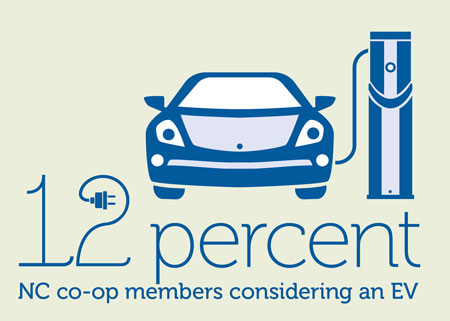Co-ops Prepare to Power Vehicles of the Future
Managing electric vehicle load so all co-op members can benefit
By Dale Lambert Modes of transportation have gone through many evolutions in the last 150 years. I can recall my grandparents sharing stories about how they routinely traveled by mule and wagon and horse and buggy. As we would pass near a specific spot off the highway in Randolph County — by automobile, of course — my grandmother would point out a particular spring where she and my grandfather would stop for lunch and water the animals. I’m glad those days are past us, and we have faster and more comfortable transportation options.
Modes of transportation have gone through many evolutions in the last 150 years. I can recall my grandparents sharing stories about how they routinely traveled by mule and wagon and horse and buggy. As we would pass near a specific spot off the highway in Randolph County — by automobile, of course — my grandmother would point out a particular spring where she and my grandfather would stop for lunch and water the animals. I’m glad those days are past us, and we have faster and more comfortable transportation options.
If we journeyed back in time to the late 1800s and early 1900s, though, the modes of transportation used for centuries were going through an unprecedented transformation. Inventors and entrepreneurs were experimenting with “horseless” options. You may be surprised to learn, as I was, that a leading option in urban areas during this time period was the electric vehicle (EV).
Electric vehicles were popular because they were quieter, more reliable and easier to drive, without the exhaust fumes that came along with gasoline- and steam-powered vehicles. At the turn of the century, electric vehicles represented approximately one-third of the “horseless” vehicles on the road. However, improvements in internal combustion engines, advancements in assembly line production that lowered vehicle costs, and limitations on the distance EVs could travel led to their early demise.
But, as the saying goes, history repeats itself. Headlines today point to the resurgence of electric vehicles, with major car manufacturers like Ford, GM and Toyota investing billions to build out EV fleets in the next decade.
Vehicle and battery manufacturers are spending billions of dollars on research and development to improve on-board technology and to address the greatest hurdle for many potential EV owners — range anxiety. The results are astounding.
The cost for Lithium-ion battery packs experienced a 24 percent drop from a year ago and are about a fifth of their cost in 2010, according to a Bloomberg New Energy Finance survey. With these being the current battery technology of choice for most car manufacturers, the expectation is that costs will continue to decrease as production increases.
Electric cooperative members across North Carolina are embracing electric vehicles and plug-in hybrids (see data on page 6). In response, North Carolina’s electric cooperatives are preparing to ensure a seamless transition to electric-powered transportation. Co-ops are working with their members to gather EV charging data in order to analyze the impact on the electrical system. Many are also developing innovative rate options that provide value to EV owners while efficiently managing this new load so all members benefit.
Even with major interstates across the state, it’s impossible for vacationers to reach North Carolina’s beautiful mountains and sunny beaches without passing through rural communities. Because electric co-ops are located in many of these areas, we are working together to create a network of charging stations that will support tourism by accommodating the charging needs of travelers, while also facilitating access to EV technologies in rural communities.
With the advancements in technology coupled with reduced cost, EV ownership is projected to grow substantially. If you should find yourself heading down this road, look to your electric cooperative as your trusted energy advisor. We’ll be here to fuel your “horseless” vehicle with safe, reliable and affordable electricity.
About the Author
Dale Lambert is CEO for Randolph EMC, located in Asheboro. He also serves as president of the North Carolina Electric Membership Corporation board of directors.-
Energy Trends
-
Share this story:







